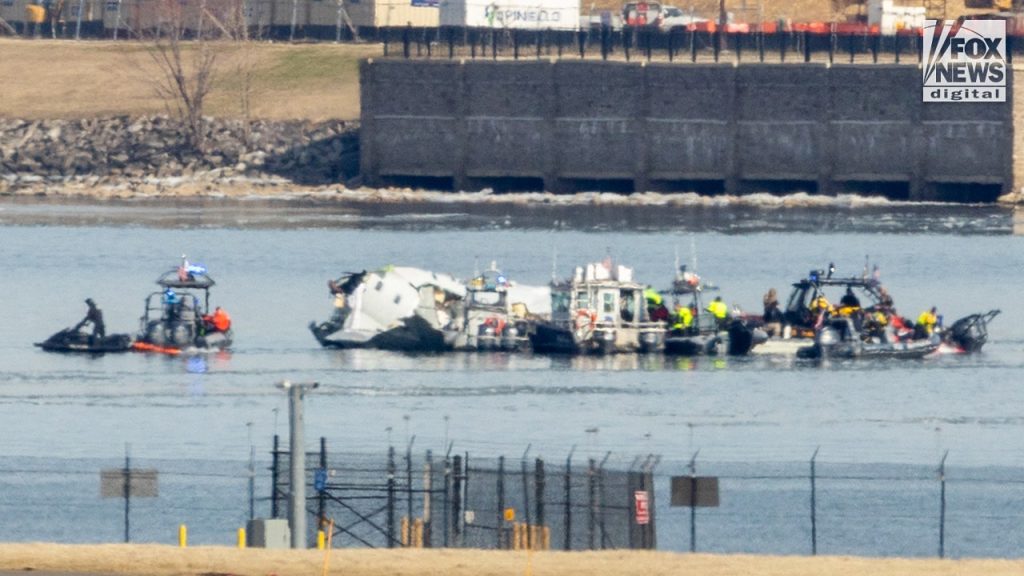The devastating midair collision between a commercial airliner and a Black Hawk helicopter over the Potomac River last week resulted in a massive recovery operation, with officials confirming the retrieval and identification of 55 bodies from the icy waters. D.C. Fire and EMS Chief John Donnelly, Sr. announced on Sunday that the remains of 55 of the 67 individuals onboard both aircraft had been identified. Remarkably, amidst the treacherous conditions, only one first responder suffered an injury – a case of hypothermia that was successfully treated. The focus now shifts to the delicate task of retrieving the submerged wreckage, slated to begin on Monday.
The U.S. Army Corp of Engineers, headed by Col. Francis Pera, expressed confidence in their planned lifting operation. A meticulous approach will be employed, with constant monitoring for human remains among the debris. Upon surfacing the wreckage onto a barge, a tent will immediately be erected to shield any recovered remains from public view and ensure respectful handling. This sensitive procedure underscores the priority placed on recovering and identifying all victims while preserving their dignity. The recovery effort has been ongoing since the tragic collision on Wednesday night, involving a Sikorsky UH-60 Black Hawk helicopter and a Bombardier CRJ700 airliner operated by PSA Airlines, a subsidiary of American Airlines.
Preliminary findings from the plane’s flight data recorder revealed a chilling sequence of events leading up to the impact. The recorder indicated that the plane was flying at an altitude of approximately 325 feet when struck by the helicopter. Furthermore, data suggests a slight increase in the plane’s pitch just moments before the collision, implying a possible attempt to avoid the impending impact. However, National Transportation Safety Board (NTSB) member Todd Inman emphasized that this information is preliminary and requires further analysis. Discrepancies between air traffic control data and the flight recorder information regarding the plane’s altitude at the time of impact are also under investigation. The NTSB awaits data from the Black Hawk’s recorder to provide a more comprehensive understanding of the tragic event.
Unraveling the exact circumstances surrounding the collision will be crucial in preventing similar incidents in the future. The complexity of the investigation is amplified by the challenging conditions at the crash site. The frigid waters of the Potomac River, coupled with near-zero visibility, present significant obstacles for divers tasked with locating and retrieving debris and remains. This harrowing recovery operation, involving the search for 67 individuals and the remnants of two aircraft, is described as incredibly unusual by Jake Crockett, a firefighter and diver with the Scuba Rescue Team of Chesterfield Fire & EMS. Crockett highlighted the stark contrast between this large-scale operation and the more typical dive rescues involving only one or two victims.
The scope of this tragedy, involving the loss of 67 lives, underscores the profound impact on families and communities. As the investigation continues, the NTSB remains committed to meticulously examining all available data, including flight recorders, air traffic control communications, and witness accounts. Determining the factors that contributed to this devastating collision will be paramount in enhancing aviation safety and preventing similar tragedies from occurring. The recovery efforts, coupled with the ongoing investigation, represent a solemn commitment to honoring the victims and providing answers to grieving families.
The challenging environment of the Potomac River, with its frigid temperatures and near-zero visibility, has made the recovery process a painstakingly slow and difficult endeavor. Divers are operating in extremely challenging conditions, meticulously searching for remains and debris in the murky waters. The recovery of the wreckage, a complex undertaking in itself, will provide further crucial evidence for investigators. The tenting of the barge upon retrieval of the debris further emphasizes the sensitivity and respect with which the authorities are handling the remains of the victims. This tragic event serves as a stark reminder of the inherent risks associated with air travel and the importance of continuous vigilance in maintaining and improving aviation safety protocols.

